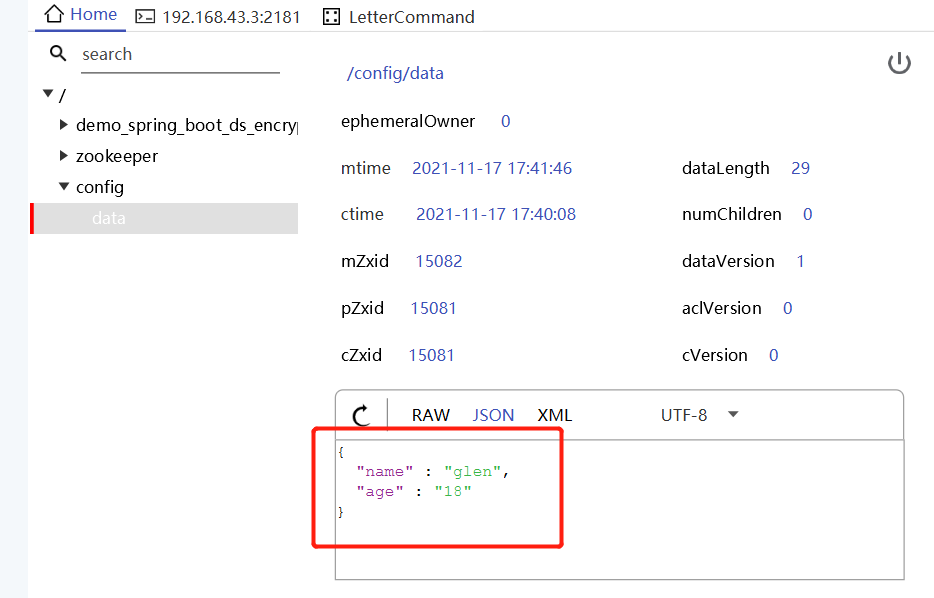分布式协调-Zookeeper(手写配置中心&动态刷新)
前面我们分析了SpringBoot加载environment的源码, 并且也聊了Zookeeper的基本使用以及特性, 这里我想对他们两个进行一个结合,实现配置中心。因为前面我们在聊ShardingSphere使用它做了配置的自动更新,我想知道它是怎么做的。后面我就在它的特性中聊到了他的watcher机制。今天把这些混合一下,手写一个配置中心,配合zk以及SpringBoot中的自动装配以及它的environment对象解析过程实现。而且,现在随着微服务节点的增多,动态配置就显得比较重要了。 下面的代码分为两步
- 手写配置中心
- 动态刷新
手写配置中心
在SpringBoot加载配置文件的源码中聊到,它里面的所有配置文件都会加载到一个environment对象中。通过@Value和注入environment对象之后就可以获取相关属性值。
并且我们可以对environment进行扩展,我们可以实现【EnvironmentPostProcessor】接口,在environment对象加载前做一些事情,大概流程为:
- 通过我们的文件名称加载使用流的形式加载文件,
- 然后把文件包装成environment对象中存储的对象,
- 然后把我们实现了这个接口的类给它进行自动装配。
 View Codepublic class CustomEnvironmentPostProcessor implements EnvironmentPostProcessor { private final Properties properties=new Properties(); //我们要加载的文件名称 private String propertiesFile="custom.properties"; @Override public void postProcessEnvironment(ConfigurableEnvironment environment, SpringApplication application) { //读取文件,并且变成一个resource对象 Resource resource=new ClassPathResource(propertiesFile); //动态给它塞在environment中,在后续就可以拿到了 environment.getPropertySources().addLast(loadProperties(resource)); } //把文件以流的形式读取到propert中,并且包装成一个对象进行返回,这个对象是environment中需要的对象类型 private PropertySource<?> loadProperties(Resource resource){ if(!resource.exists()){ throw new RuntimeException("file not exist"); } try { //custom.properties properties.load(resource.getInputStream()); return new PropertiesPropertySource(resource.getFilename(),properties); } catch (IOException e) { throw new RuntimeException(e); } } }
View Codepublic class CustomEnvironmentPostProcessor implements EnvironmentPostProcessor { private final Properties properties=new Properties(); //我们要加载的文件名称 private String propertiesFile="custom.properties"; @Override public void postProcessEnvironment(ConfigurableEnvironment environment, SpringApplication application) { //读取文件,并且变成一个resource对象 Resource resource=new ClassPathResource(propertiesFile); //动态给它塞在environment中,在后续就可以拿到了 environment.getPropertySources().addLast(loadProperties(resource)); } //把文件以流的形式读取到propert中,并且包装成一个对象进行返回,这个对象是environment中需要的对象类型 private PropertySource<?> loadProperties(Resource resource){ if(!resource.exists()){ throw new RuntimeException("file not exist"); } try { //custom.properties properties.load(resource.getInputStream()); return new PropertiesPropertySource(resource.getFilename(),properties); } catch (IOException e) { throw new RuntimeException(e); } } }那既然这样,我们是不是就可以把这些配置文件中的属性,放在zk上呢,当项目启动的时候,我们自动加载这些属性,并且给它塞在environment中呢?
首先,我们在zk上写上我们的配置文件
- 编写一个类,这个类会在SpringBoot中的refresh(也就是容器初始前进行调用),因为这个类实现了【ApplicationContextInitializer】,并且对这个类进行自动装配,在这个类中对所有实现了下面的这个接口的实现类进行加载,并且获取他们返回的PropertySource对象,然后把这些放在environment中
- 编写一个接口,所有实现了这个接口的类,都可以对他们想要交给environment对象的配置文件进行加载,并且包装成一个PropertySource集合进行返回。当然这个接口对应的实现类和接口本身都要进行自动装配,key是接口的全限定名,value是实现类的名称。
实现了接口的zk配置文件获取类
//这里配置文件下的子节点 private final String DATA_NODE="/data"; // 连接zk public ZookeeperPropertySourceLocator() { curatorFramework= CuratorFrameworkFactory.builder() .connectString("192.168.43.3:2181") .sessionTimeoutMs(20000) .connectionTimeoutMs(20000) .retryPolicy(new ExponentialBackoffRetry(1000,3))
//这里是保存我们配置文件的节点 .namespace("config") .build(); curatorFramework.start(); } // 加载配置文件 @Override public PropertySource<?> locate(Environment environment, ConfigurableApplicationContext applicationContext) { //加载远程Zookeeper的配置保存到一个PropertySource System.out.println("开始加载外部化配置"); //这里Spring中提供的一种PropertySource类型,因为在environment中放的都是这个类型 CompositePropertySource composite=new CompositePropertySource("configService"); try { //这里是我们从zk上获取的文件 Map<String,Object> dataMap=getRemoteEnvironment(); //给这个PropertySource起一个名称 MapPropertySource mapPropertySource=new MapPropertySource("configService",dataMap); composite.addPropertySource(mapPropertySource); } catch (Exception e) { e.printStackTrace(); } //并且返回 return composite; } // 从远程获取配置信息 private Map<String,Object> getRemoteEnvironment() throws Exception { //从data节点下面获取的配置信息 String data=new String (curatorFramework.getData().forPath(DATA_NODE)); //支持JSON格式 ObjectMapper objectMapper=new ObjectMapper(); return objectMapper.readValue(data,Map.class); } }整体流程:,Spring容器初始化之前,会调到我们实现了它这个接口【ApplicationContextInitializer】中的initialize方法,这个方法中对实现了我们所有加载environment的类的locateCollection进行执行,并且把返回的environment所要的PropertySource塞入environment中,这样当我们获取某个属性的时候就能从environment中获取了。
测试:我们看源码发现Banner是在整体初始化前面打印的,而这句话是在banner前面打印的,也就是说在整体初始化前就执行了我类中的方法。
我们现在的配置文件中是没有数据的,但是我们现在通过@Value注解依然可以获取到数据,那就是说,他已经加载到了zk上的配置文件,但是当修改的时候还是没有动态刷新,下面我们对他进行动态刷新。
动态刷新配置
流程粗粒度:
- 整体使用watcher和Spring中的事件进行操作,我们使用watcher监控存储配置文件的节点,当节点变化通知我们,我们去发送一个Spring事件去通知我们的事件操作类(ConfigurationPropertiesRebinder),在里面对有@Value注解的类中的属性进行反射赋值。
流程细粒度:
- 前面我们在初始获取zk上的数据的时候就注册一个事件(NodeDataChangeCuratorCacheListener),这个事件是监控zk上存储配置文件变化的事件,一旦变化,zk就会来调用我们NodeDataChangeCuratorCacheListener中的event方法,它也会把监控的节点的数据传递过来,就是我们新修改的配置文件。
- 我们把获取到的新的配置文件变成map的形式,然后把environment中的存储zk上配置文件的value数值进行替换,这样就对配置文件进行了动态替换,然而这里并没有对bean中的属性进行重新赋值。
- 那这个时候我们就去发送一个SpringBoot的事件,在SpringBoot收到事件后对我们存储所有@Value的属性的Map循环遍历,并且拿到environment中的内容反射赋值到这些属性中,这个时候我们就可以得到动态的数值了。
- 这个存储拥有@Value的数值的map是在我们Spring中bean被加载后我们实现BeanPostProcessor中的postProcessBeforeInitialization方法进行收集的(我们写一个自定义注解,所有拥有我们自定义注解,并且有@Value的注解的类,我们都要进行扫描获取属性。)
【代码】
- 在我们上面Spring加载前的 ZookeeperPropertySourceLocator 中的locat方法中注册一个事件
- 事件中替换environment中的配置,并且注册一个事件同时Spring进行反射赋值
- 注册事件,以及反射赋值
- 反射赋值方法。
- 收集注解的bean执行后操作。收集@Value中的属性,并且维护成一个个FieldPair对象,并且存储在map中,之后要对这些对象中的属性反射赋值。
- 自定义标注注解,这个注解你可以标记到任何你想获取动态配置的类中,上面的代码将会对它进行扫描
- 至此,动态刷新注册中心完成
- 以后我们想要扩展的话,直接实现PropertySourceLocator接口下的方法就行,并且把实现接口的类让SpringBoot去装配就行。流程为,我们在Spring初始之前,就加载了实现PropertySourceLocator的所有类,并循环执行了他们包装PropertySource的方法,然后把这些对象都放在了environment中了。相当于我们PropertySourceLocator变成了自动装配的key了。






